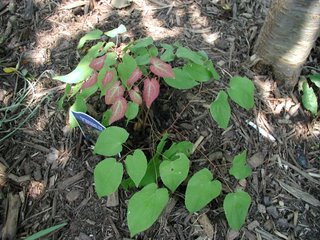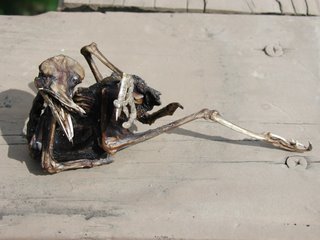Epimedium, barrenworth

We had a tiny epimedium (barrenwort) for several years until we moved and I missed that tiny plant with white flowers in spring. We bought it at a much beloved nursery but now closed when the owner died. He had many unique plants sold very cheaply because they were small, in tiny 1" pots, majority of the plants for $.99 to $4.99 for 4" pots you don't find in the run of the mill nurseries or big box stores. He grew many of the plants from seed in his extensive greenhouses. We were always so excited to go there in Spring to look at the vast selection of plants so much so that a couple of years we arrived too early only to be turned back by a CLOSED not open until ... sign. Anyway, I missed the epimedium so much, I looked for it on the internet and purchased three varieties: Epimedium pubigerum 'Orange King', Epimedium x rubrum, Epimedium x versicolor 'Sulphureum'. Apparently epimedium is also used as a herb to improve libido and is sold as horny goat weed! Imagine that! These herbal purveyors are getting carried away with descriptions as the horticultural books don't describe epimedium as "horny goat weed". I think it these plants would go well with the other wild shade plants listed above although some of the varieties are considered be ground cover. To my disappointment I was not able to buy the one that seemed to be the one we had previously which is the Epimedium diphyllum. Perhaps at a later date. Actually after further investigation I think it's the Epimedium x youngianum 'White Star' not the diphyllum.
While looking for epimediums I found a site that sold lovely Chinese and Japanese epimediums but the prices were beyond what I was willing to pay $20 and up. Good to know what's out there to drool over.
Here's a photo of the newly planted Epimedium x rubrum.
Here are some websites: http://www.bbc.co.uk/gardening/plants/plantprofile_epimedium.shtml
and nurseries:
http://asiaticanursery.com/index.php/cPath/29?osCsid=73a6425f3926572bf6913
http://www.plantdelights.com/Catalog/Spring/page37.html
http://collectorsnursery.com/catalog/index.php?cPath=13
http://www.bigdipperfarm.com/cgi-bin/searchstuff.pl?Botanical=Epimedium
http://www.deerxlandscape.com/cgi-bin/webc.cgi/st_main.html?p_catid=136



























